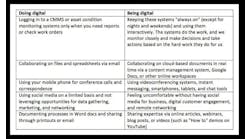Case Study: How Kawasaki Heavy Industries digitally transformed its business
By Verl McQueen, Aras Corporation product marketing manager
With six companies and 95 subsidiaries, 36,000 employees on six continents and more than $14.5 billion in annual revenue, Kawasaki Heavy Industries, Ltd.(KHI) serves a global customer base in dynamically changing markets.
Operating in a global environment, KHI is not immune to the challenges that many organizations face—as market demands are changing rapidly, there is a shift from selling products to providing a customer experience, as well as fierce competition and restructuring happening throughout the industry. Even with these realities, it has set the ambitious goals of a 5% growth every year, totaling 70% growth, by 2030.
So how are they going about that?
To meet its customers’ ever-evolving needs and ambitious internal goal, KHI launched two major initiatives—Business Model Innovation and Product and Service Innovation.
The manufacturing giant plans on streamlining existing product development, manufacturing and sales and logistic processes while investing in operations, services and maintenance. KHI also plans on starting subscription-based businesses while accommodating to an aging workforce and a renewed commitment to global sustainability. Understanding that this alone will not meet its growth targets, it will simultaneously respond to new markets and create a partner ecosystem to foster disruptive innovation for its products and services.
The key to this strategy is leveraging advanced IT technology across its value chain. (Sound familiar?)
They have begun capturing market needs based on insights from social networking channels and information from IoT sensors to refine and develop products. IoT data is critical for predictive maintenance and forms the foundation for a subscription-based business. KHI visualizes and streamlines processes by employing applications such as CRM, PDM, ERP and MES. However, each of these applications can be isolated within the individual processes, which can limit efforts. Realizing the need for a unifying technology to tie the disparate technologies and processes together, KHI decided to employ a PLM platform as the backbone for its strategy and vision. (Full disclosure: they chose Aras.)
“The challenges for our PLM platform was to shorten the implementation period and reduce costs,” said Yutaro Mishima, senior staff officer in KHI’s IT Strategy Planning Center. “The goal was to share process innovations with one another faster and greatly reduce excess charges.”
Operating in an environment of separate business units, each with its own requirements, processes and regulations, posed a strategic challenge, which KHI is addressing by offering the PLM platform-as-a-service to several of its companies. The platform is deployed by headquarters and includes licenses, hardware and operations-as-a-service. Individual companies are then free to develop their own applications for their specific functional requirements resulting in several benefits: company requirements are already incorporated, low deployment costs, rapid implementation, and a common interface for all parties. The platform is a unifying technology across the enterprise.
However, this strategy can only be employed if the platform will support it; the platform must have three critical characteristics for success—flexibility, agility and sustainability.
Since each KHI company has its own business processes, supply chain, culture and functional requirements, the platform must be flexible and easily customizable to meet each company’s specific needs. Within two years, four of KHI’s six companies had deployed Aras Innovator and a new business unit was using it as the core of its quality-management system. This can only be accomplished with a platform that is inherently flexible.
Within three years, a total of 14 projects were initiated. Of those projects, 12 were completed in less than six months; six were completed in less than three months. Compared to other PLM tools for ongoing large-scale projects, it reduced implementation costs by more than 70%.
KHI is focused on business sustainability. Many of its products such as ships, aircrafts and trains have long lifecycles. Getting stuck in outdated, customized technology that is often expensive to upgrade to new versions is not sustainable. KHI has had three upgrades so far, all completed within three months and with zero external costs.
By upgrading its PLM system from multiple siloed systems to one unified platform, the company was able to streamline new product development and optimize costs. Now, KHI is poised to survive and thrive through rapid, disruptive innovation while building a sustainable partner ecosystem.


